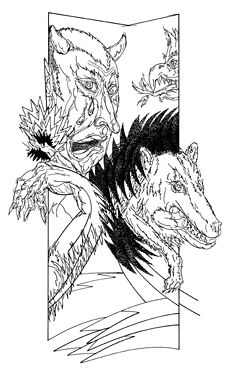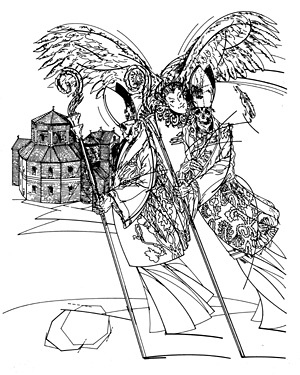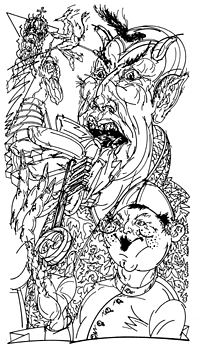Aachen legends and fairy tales
WHAT CONNECTS AACHEN…
The construction of Aachen Cathedral
Or how the people of Aachen outwitted the devil
Charlemagne wanted to build the largest and most beautiful church ever seen north of the Alps at his headquarters in Aachen. He ordered the most skilled craftsmen and the best materials to Aachen, and the work initially progressed well. But then Emperor Charles went to war against the Saxons and instructed the city council to supervise further construction work.
It came as it had to: the city ran out of money, because cathedral construction and war were expensive. The city fathers were at a loss – where would they get the money to finish the cathedral? Would they even have to borrow it from the devil himself? And indeed, at the next council meeting, a fine, unknown gentleman appeared and offered the Aacheners the necessary money. He demanded only one small thing in return: the first soul to enter the finished cathedral was to be his.
At these words the gentlemen turned pale, for they had obviously received an offer from the devil! But what else could they do but accept it? With the devil’s gold, they achieved the miracle: when Charlemagne returned to Aachen, his magnificent church was finished. The emperor was proud of the city council, but it had long since had other worries: for the soul that the devil was to receive for his money was that of Pope Leo III. As the highest-ranking clergyman, he would be the first to enter the church to consecrate it.
This was unimaginable! At the last minute, a clever monk had the saving idea: Where was it written that it had to be a human soul? With short decision, the people of Aachen chased a wolf into the cathedral before the consecration. The devil was already lurking behind the door in the dark church, immediately pounced greedily on the first visitor and blindly tore his soul out of his body.
When he realized his mistake, he became very angry. Enraged, he rushed out of the minster and slammed the heavy portal so hard behind him that it cracked, crushing one of the devil’s thumbs. The finger fell into the doorknob, where you can still feel it – now hard as iron. In the vestibule of the cathedral, two bronze figures commemorate the wolf and his soul.

Klappergassen legend
Or how Klappergasse got its name
When Charlemagne returned home victorious from the war against the Saxons in 805, it filled him with great joy to see that Aachen Cathedral was completed. As an expression of his deep faith, the festive consecration of the cathedral on Epiphany was to be celebrated with particular pomp in honor of God: In addition to Pope Leo III, not only were numerous counts and prelates expected to attend the feast, but also 365 bishops, one for each day of the year.
On the eve of the cathedral’s consecration, however, only 363 bishops gathered in Aachen – much to the disappointment of Emperor Charles. God, however, was so moved by the Emperor’s reverence that he wanted to fulfill his wish: so he sent an angel to Maastricht’s St. Servaas Church to send the two bishops buried there, Mundolph and Gundolph, on their final journey to Aachen Cathedral. The angel called out in a loud voice: “Mundolph and Gundolph, arise and go to Aachen. There you shall participate in the consecration of the church of Emperor Charles”. The two skeletons immediately left their graves to carry out the angel’s command.
As the two dignitaries approached Aachen Cathedral, the clatter of their bones could be heard clearly from afar. Hastily the bishops entered the cathedral and sat down on the last two free seats. Thanks to this miracle, there were now actually 365 ministers of God present for the consecration of the cathedral. Mundolph and Gundolph left the city after the ceremony the same way they had come, to finally lay to eternal rest in Maastricht.
What remains of Aachen from these two extraordinary visitors is the name of the small alley that leads to the cathedral from the west: Klappergasse. Today, at the monastery “Vom armen Kind Jesu” in Klappergasse, you can find a relief of the two dead bodies. This Hau stone was donated to the citizens of Aachen by the city of Maastricht in 1956.

Lousberg legend
Or how the devil was tricked again
In his anger at the people of Aachen – after all, he had been cheated out of the wages for his help in building the cathedral – the devil swore revenge. He fetched two huge sacks of sand from the North Sea coast, for he had decided to simply fill up Aachen Cathedral and, best of all, the entire city, including its inhabitants. But the way back to Aachen was long and an annoying wind was constantly blowing his own sand in his face. The burden on his back was so heavy that the devil finally, at the end of his strength and almost blinded by the sand in his eyes, took a break. He did not notice that he had almost made it, for the Pont Gate was not far away.
As the devil stood there doubting if he would even make it to Aachen with his luggage, an old farmer’s wife came by. He asked her how far it was to Aachen. “Look at my shoes!” said the clever farmer’s wife, pointing to her old, holey shoes. She had seen the horse’s foot of her counterpart and guessed that he was up to no good with the sacks. “I bought these at the market in Aachen this morning, and now they’re completely worn through, that’s what!” At this the devil howled with rage, for he would certainly not get that far with his load. With a terrible curse he threw the two sacks away and stormed off. He had no idea that the crafty people of Aachen had outwitted him once again.
Since that time, there has been a saying in Aachen: “De Oecher send der Düvel ze lous” – the people of Aachen are too clever for the devil. The sacks have since become the Lousberg and the Salvatorberg in the northeast of Aachen. In fact, these hills consist of pure sea sand, and in their rock one can even find the remains of shells. In 1985, the artist Krista Löneke-Kemmerling set the monument “Devil and Market Woman” to the cunning Aachen farmer’s wife, which recalls the legend at the foot of the Lousberg.

Printen legend
Or: How the devil once again lost out
The great fire of Aachen in 1656 almost brought the city and its citizens to ruin. But a clever baker’s apprentice knew how to prevent this: He got involved with the devil.
When the city was burned out, the people were suffering from hunger and winter was just around the corner, people in need remembered the old favorite pastry of Emperor Charles, the Aachen Printen. The sale of this sweet, unique-tasting pastry would not only satisfy the people of Aachen, but also fill the city’s coffers. But how could one get hold of the recipe that the emperor had taken to his grave? No one knew exactly where the emperor’s tomb was. So devilish help was needed.
When Beelzebub offered to take the baker’s boy to the emperor’s burial chamber at night, he demanded the key to the treasure chamber in return. No sooner said than done. The very next night, thanks to the help of the devil, the boy was standing in the emperor’s tomb. Annoyed, the latter opened his eyes and asked the reason for the disturbance. The baker’s apprentice’s desperate description of the town’s plight touched the emperor’s heart: “I have always loved this town and its inhabitants, so I will gladly help them”. With these words, he handed the recipe to the baker’s apprentice.
Happy, the boy hurried to his master, who, after initial horror at his apprentice’s deed, immediately set about baking the imperial Printen. Thanks to their wonderful smell and taste, they were soon in demand far beyond the city limits and the misery of the people of Aachen had come to an end. When the devil demanded his wages from the apprentice, the latter cunningly offered him some of the freshly baked hot Printen. The devil greedily gobbled them down together with the baking tray. Plagued by hellish pain, the devil had to realize once again that he was no match for the cleverness of the Aachener – and descended into hell, cursing loudly.
